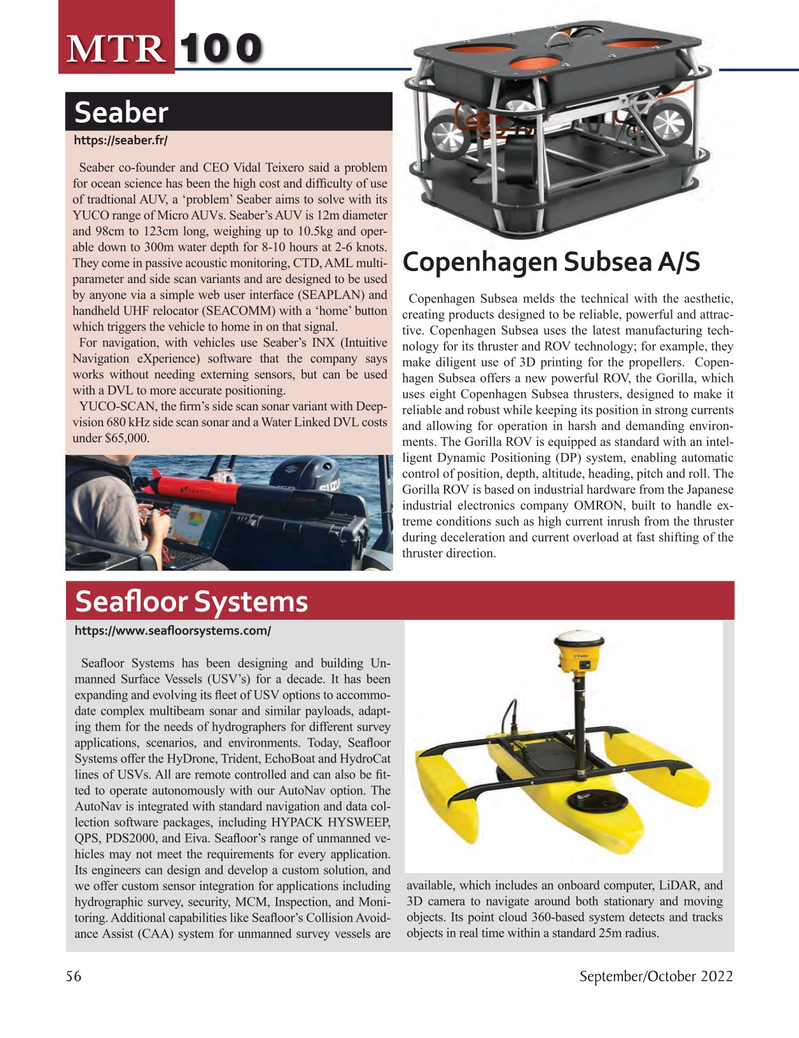
Page 56: of Marine Technology Magazine (September 2022)
Read this page in Pdf, Flash or Html5 edition of September 2022 Marine Technology Magazine
MTR 100
Seaber https://seaber.fr/
Seaber co-founder and CEO Vidal Teixero said a problem for ocean science has been the high cost and dif? culty of use of tradtional AUV, a ‘problem’ Seaber aims to solve with its
YUCO range of Micro AUVs. Seaber’s AUV is 12m diameter and 98cm to 123cm long, weighing up to 10.5kg and oper- able down to 300m water depth for 8-10 hours at 2-6 knots.
They come in passive acoustic monitoring, CTD, AML multi-
Copenhagen Subsea A/S parameter and side scan variants and are designed to be used by anyone via a simple web user interface (SEAPLAN) and
Copenhagen Subsea melds the technical with the aesthetic, handheld UHF relocator (SEACOMM) with a ‘home’ button creating products designed to be reliable, powerful and attrac- which triggers the vehicle to home in on that signal. tive. Copenhagen Subsea uses the latest manufacturing tech-
For navigation, with vehicles use Seaber’s INX (Intuitive nology for its thruster and ROV technology; for example, they
Navigation eXperience) software that the company says make diligent use of 3D printing for the propellers. Copen- works without needing externing sensors, but can be used hagen Subsea offers a new powerful ROV, the Gorilla, which with a DVL to more accurate positioning. uses eight Copenhagen Subsea thrusters, designed to make it
YUCO-SCAN, the ? rm’s side scan sonar variant with Deep- reliable and robust while keeping its position in strong currents vision 680 kHz side scan sonar and a Water Linked DVL costs and allowing for operation in harsh and demanding environ- under $65,000.
ments. The Gorilla ROV is equipped as standard with an intel- ligent Dynamic Positioning (DP) system, enabling automatic control of position, depth, altitude, heading, pitch and roll. The
Gorilla ROV is based on industrial hardware from the Japanese industrial electronics company OMRON, built to handle ex- treme conditions such as high current inrush from the thruster during deceleration and current overload at fast shifting of the thruster direction.
Sea? oor Systems https://www.sea? oorsystems.com/
Sea? oor Systems has been designing and building Un- manned Surface Vessels (USV’s) for a decade. It has been expanding and evolving its ? eet of USV options to accommo- date complex multibeam sonar and similar payloads, adapt- ing them for the needs of hydrographers for different survey applications, scenarios, and environments. Today, Sea? oor
Systems offer the HyDrone, Trident, EchoBoat and HydroCat lines of USVs. All are remote controlled and can also be ? t- ted to operate autonomously with our AutoNav option. The
AutoNav is integrated with standard navigation and data col- lection software packages, including HYPACK HYSWEEP,
QPS, PDS2000, and Eiva. Sea? oor’s range of unmanned ve- hicles may not meet the requirements for every application.
Its engineers can design and develop a custom solution, and we offer custom sensor integration for applications including available, which includes an onboard computer, LiDAR, and hydrographic survey, security, MCM, Inspection, and Moni- 3D camera to navigate around both stationary and moving toring. Additional capabilities like Sea? oor’s Collision Avoid- objects. Its point cloud 360-based system detects and tracks ance Assist (CAA) system for unmanned survey vessels are objects in real time within a standard 25m radius.
56 September/October 2022
MTR #7 (50-65).indd 56 10/3/2022 8:57:00 AM

 55
55

 57
57
